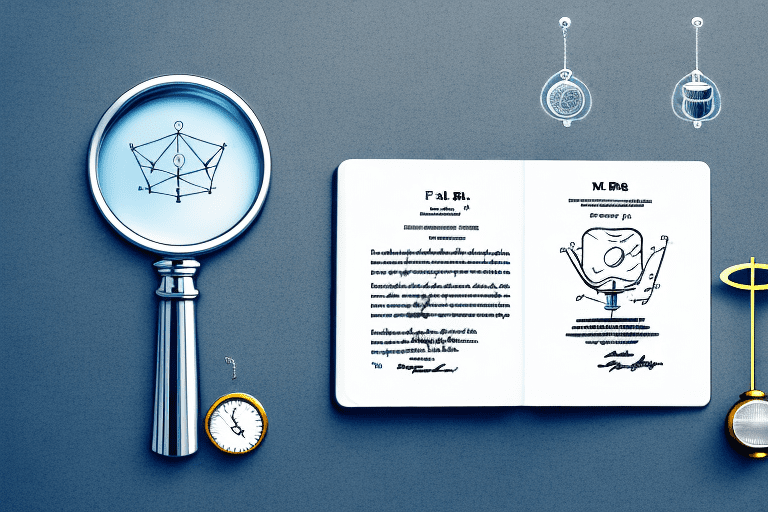In the world of intellectual property law, understanding various aspects of patents is essential. One such aspect is fair use, which plays a significant role in copyright law but is also relevant in the context of patent law. Additionally, navigating the complex world of patents requires access to resources like the Manual of Patent Examining Procedure (MPEP), while aspiring patent practitioners must also tackle a crucial step known as the Patent Bar Examination. In this article, we will explore these topics, delving into the concept of fair use, understanding patents, examining the MPEP, and grasping the significance of the Patent Bar. So, let’s begin our exploration of “Fair use: Exploring a Patent, the MPEP, and the Patent Bar.
Understanding the Concept of Fair Use
When discussing intellectual property rights, the concept of fair use often arises. Fair use refers to the limited use of copyrighted material without obtaining permission from the copyright holder. It allows individuals to utilize copyrighted content for purposes such as criticism, comment, news reporting, teaching, scholarship, or research. The importance of fair use lies in its ability to strike a balance between protecting the rights of content creators and promoting the exchange of ideas and information. To comprehend the significance of fair use in patent law, let’s examine it within this specific context.
Definition and Importance of Fair Use
Within the realm of patent law, fair use refers to the limited use of patented technology without infringing on the patent holder’s exclusive rights. It allows for the lawful utilization of patented inventions in specific circumstances, such as for private and non-commercial purposes or for experimental or educational use. This concept is crucial as it encourages innovation and allows individuals and organizations to build upon existing patented technology for further advancements.
Fair Use in the Context of Patent Law
Applying fair use principles to patent law can be complex. While copyright fair use involves various factors to consider, such as the purpose and character of the use, the nature of the copyrighted work, the amount and substantiality of the portion used, and the effect of the use on the potential market, fair use in patent law operates differently. In patent law, fair use is often seen through the lens of research, experimentation, and development of new inventions. It enables inventors and researchers to explore patented technology without fear of infringement, facilitating progress in numerous fields.
One example of fair use in patent law is the concept of “prior art.” Prior art refers to any existing knowledge or information that is publicly available before a patent application is filed. It includes patents, patent applications, scientific articles, technical papers, and other publicly accessible information. Prior art serves as a foundation for the examination of patent applications, helping patent examiners determine the novelty and non-obviousness of an invention. By allowing access to prior art, fair use in patent law ensures that inventors can build upon existing knowledge and contribute to technological advancements.
Moreover, fair use in patent law extends beyond the realm of research and development. It also plays a significant role in promoting competition and preventing monopolies. Patent holders have exclusive rights to their inventions for a limited period, typically 20 years from the filing date. However, during this period, other inventors may still be able to make fair use of patented technology. This allows for the development of alternative solutions or improvements, fostering healthy competition and benefiting consumers.
Additionally, fair use in patent law recognizes the importance of public interest. In certain cases, the public may require access to patented technology for essential purposes such as public health or safety. For example, during a public health crisis, the government may invoke fair use to produce generic versions of patented drugs to ensure widespread availability and affordability. This demonstrates how fair use in patent law serves the greater good by balancing the interests of patent holders and the public.
In conclusion, fair use is a fundamental concept in both copyright and patent law. While copyright fair use allows for the limited use of copyrighted material, fair use in patent law enables the lawful utilization of patented technology. It encourages innovation, research, and development, while also promoting competition and safeguarding public interest. By understanding and applying fair use principles, we can foster a dynamic and progressive intellectual property landscape.
A Deep Dive into Patents
Before fully grasping the concept of fair use and its implications within patent law, it is important to understand what patents are and the process of obtaining them.
Patents are a fascinating aspect of intellectual property law that play a crucial role in fostering innovation and protecting inventors’ rights. In this article, we will delve deeper into the world of patents, exploring their definition, the intricate process of obtaining them, and their significant impact on innovation and economic growth.
What is a Patent?
A patent is a form of intellectual property protection granted by the government to an inventor or assignee, giving them exclusive rights over their invention. It is a powerful tool that enables inventors to safeguard their creations and prevent others from using or profiting from them without permission.
When an inventor successfully obtains a patent, they are granted a legal monopoly over their invention for a specified period, typically 20 years from the filing date. This exclusivity empowers inventors to control the production, use, sale, and importation of their invention, allowing them to capitalize on their ingenuity and hard work.
Patents serve as a fundamental pillar of the intellectual property system, encouraging inventors to push the boundaries of innovation by providing them with a tangible reward for their efforts. This reward takes the form of exclusive rights, which not only incentivize inventors but also promote technological advancement and societal progress.
The Process of Obtaining a Patent
The journey to obtaining a patent is a meticulous and thorough process that ensures the invention meets specific criteria before being granted exclusive rights. Let’s explore the key steps involved in this process:
The first step in obtaining a patent is filing a patent application with the relevant patent office. This application serves as a detailed description of the invention, highlighting its unique features and functionality. The application must be comprehensive, providing sufficient information for patent examiners to evaluate its novelty, usefulness, and non-obviousness.
Once the patent application is filed, it undergoes a rigorous examination by patent examiners. These experts meticulously review the application, comparing the invention to existing patents and prior art to determine its novelty and non-obviousness. They assess whether the invention brings something new and inventive to the table, pushing the boundaries of existing knowledge.
If the invention successfully meets the patentability criteria and there are no prior conflicting patents, the patent office grants the inventor a patent. This grant marks a significant milestone for inventors, as it provides them with legal protection and exclusive rights over their invention for the specified duration.
It’s important to note that the patent application process can be complex and time-consuming. Inventors often seek the assistance of patent attorneys or agents to navigate this intricate journey, ensuring their application meets all the necessary requirements and stands the best chance of success.
The Role of Patents in Innovation and Economic Growth
Patents play a pivotal role in driving innovation and fostering economic growth. They serve as a catalyst for inventors, providing them with the motivation and security needed to invest time, effort, and resources into developing groundbreaking technologies and solutions.
By granting exclusive rights, patents create a competitive advantage for inventors. This advantage encourages inventors to disclose their inventions in the patent application, contributing to the transfer of knowledge and the overall growth of society. The information shared in patent applications becomes part of the public domain, allowing others to build upon existing inventions and drive further innovation.
Furthermore, patents incentivize investment in research and development. Companies and individuals are more likely to allocate resources to innovation when they know they can protect their inventions and reap the rewards. This investment leads to the creation of new industries, job opportunities, and economic prosperity.
Patents also foster competition and drive technological advancements. The exclusivity granted by patents encourages inventors to continuously improve their inventions, seeking ways to outperform competitors and gain a larger market share. This healthy competition results in a steady stream of innovative products and services that benefit consumers and society as a whole.
In conclusion, patents are a vital component of the intellectual property landscape. They provide inventors with the necessary protection and incentives to push the boundaries of innovation, contributing to economic growth and societal progress. By understanding the intricacies of patents, we can appreciate their significance and the profound impact they have on our world.
The Manual of Patent Examining Procedure (MPEP)
The Manual of Patent Examining Procedure (MPEP) serves as a comprehensive guide to patent examiners, attorneys, and inventors navigating through the complex world of patents. Let’s explore the importance of the MPEP and how it aids in the examination of patent applications.
An Overview of the MPEP
The MPEP is a detailed compilation of guidelines, rules, and procedures that govern the examination of patent applications by the United States Patent and Trademark Office (USPTO). It provides patent examiners and practitioners with a comprehensive resource to understand the laws, rules, and best practices followed in the patent examination process. The MPEP covers various topics, including the application process, examination guidelines, patentability requirements, and post-grant proceedings.
The Importance of the MPEP in Patent Law
The MPEP plays a pivotal role in patent law by ensuring consistency and uniformity in the examination of patent applications. It provides guidance to patent examiners, enabling them to apply the relevant rules and regulations when assessing the patentability of an invention. The MPEP also serves as a reference for patent attorneys, enabling them to provide accurate advice to inventors and effectively navigate the patent application process.
How to Navigate the MPEP
Given the extensive nature of the MPEP, effectively navigating through it is essential. The MPEP consists of various chapters, each focusing on different aspects of the examination process. Users can utilize the table of contents, search functionality, or specific chapter listings to find the relevant information. By utilizing the MPEP effectively, patent examiners, practitioners, and inventors can ensure that they are following the correct procedures and guidelines throughout the patent application process.
The Patent Bar: An Essential Step for Patent Practitioners
For individuals looking to practice patent law, passing the Patent Bar Examination is a crucial step. Let’s dive into the details of this exam, along with tips and strategies to excel in it.
Understanding the Patent Bar Examination
The Patent Bar Examination is a challenging test conducted by the USPTO to assess the knowledge and competency of individuals seeking to become registered patent practitioners. The exam covers various aspects of patent law, including patent eligibility, prior art, patent prosecution, and patent ethics. Passing this exam is a prerequisite for representing clients before the USPTO.
Preparing for the Patent Bar: Tips and Strategies
Preparing for the Patent Bar Examination requires a dedicated approach and familiarity with the exam’s content. Aspirants should start by understanding the exam structure, content, and the reference materials provided by the USPTO. Creating a study schedule, utilizing study aids, practicing with past exams, and seeking guidance from experienced patent practitioners can enhance preparation efforts. Additionally, maintaining an updated knowledge of recent developments in patent law and staying aware of changes in the USPTO’s rules and procedures are essential elements of successful exam preparation.
The Role of the Patent Bar in Upholding Patent Law Standards
By ensuring that only qualified individuals can practice before the USPTO, the Patent Bar plays a vital role in upholding the standards of patent law. The exam assesses an individual’s knowledge, ethical conduct, and ability to represent clients in patent-related matters. As registered patent practitioners adhere to strict ethical standards, their presence ensures the integrity of the patent examination process and the protection of inventors’ rights.
In conclusion, fair use, patents, the MPEP, and the Patent Bar constitute significant elements of patent law. Understanding fair use within the context of patent law allows for the ethical exploration of patented technology. Patents, on the other hand, protect inventors’ exclusive rights and incentivize innovation. The MPEP serves as a comprehensive guide for patent examiners and practitioners, aiding in the examination of patent applications. Lastly, the Patent Bar Examination ensures the competency of those representing clients before the USPTO. By exploring these topics, we gain valuable insights into the multifaceted world of “Fair use: Exploring a Patent, the MPEP, and the Patent Bar.”






